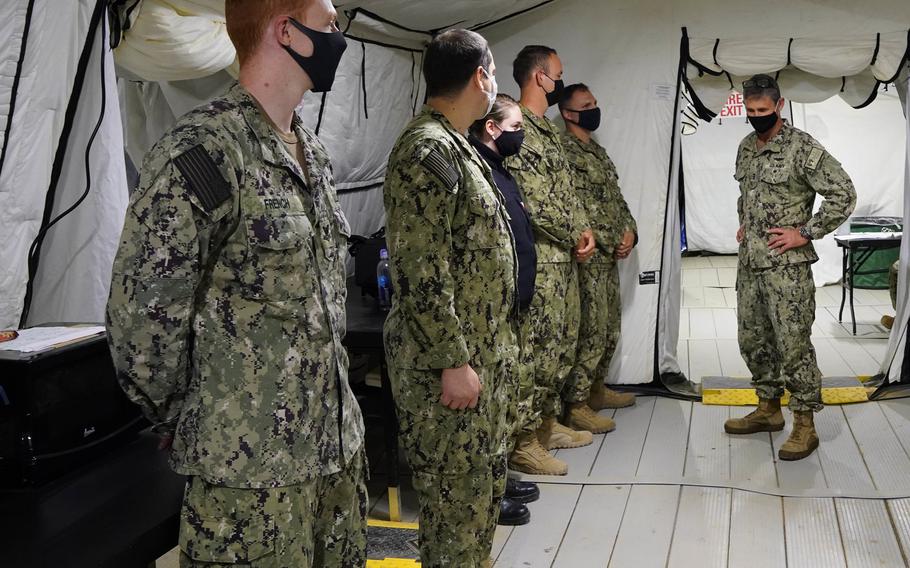
Vice Adm. Andrew Lewis, Commander, U.S. 2nd Fleet, speaks with a group of sailors he intends to present a challenge coin to during a visit to the U.S. 2nd Fleet’s Expeditionary Maritime Operations Center (ExMOC) Joint Expeditionary Base Little Creek-Fort Story on Aug. 11, in support of Large-Scale Exercise (LSE) 2021. (Jahlena Royer/U.S. Navy)
VIRGINIA BEACH, Va. (Tribune News Service) — U.S. 2nd Fleet planners and operations staff usually direct East Coast ships and units from the second floor of their headquarters. But a just-completed globe-spanning Navy exercise brought a team of more than 50 to a tent at Little Creek to practice in war-like conditions.
“You never really know what you can do until game day,” said Vice Adm. Andrew Lewis, 2nd Fleet’s commanding officer and one of the five fleet commanders participating in Large-Scale Exercise 2021, the first such global exercise since the height of the Cold War.
Operating in an ad hoc maritime operations center — such as the 760-square-foot tent at Little Creek, where torrential rains caused mud to bubble up through the floorboards — is a 2nd Fleet specialty. It was the seventh such operations center the fleet has run since the Navy reconstituted it in 2018.
Most recently, this meant the fleet’s vice commander, Canadian Rear Admiral Steve Waddell, along with staff from Norfolk — including a French naval officer on temporary assignment — ran the maritime operations center in Europe.
The 2nd Fleet group set up its temporary shop on an unfamiliar U.S. Navy warship home-ported in Italy and directed operations off the coast of Portugal.
There’s a strong international flavor at 2nd Fleet, since its commander is also in charge of NATO’s new Joint Force Command Norfolk, which is responsible for operations in the North Atlantic “from Florida to Finnmark (northernmost Norway) and from the seabed to space,” as Lewis likes to say.
“It was like having two start-ups getting fully up to speed in just a couple of years,” said Lewis, who took charge of 2nd Fleet with its relaunch, while also taking on the task of leading the new NATO command.
Running the operations center for this year’s NATO exercise was an intensive drill on managing ships, sailors, Marines and aviators from 10 nations, including the largest deployment of Fleet Air Arm helicopters in a decade.
“I can’t stress how important the alliance is,” Lewis said. “The difference with the United States is, we have friends and we keep friends.”
Working in the tent at Little Creek, fleet staff, sailors and Marines simulated rapid transfers of responsibility and reporting channels that come when dealing with a global threat.
“It’s about transparency … you’ve got to know who’s at the other end of the line,” Lewis said.
The Large-Scale Exercise was a chance for 2nd Fleet and Little Creek-based Navy Expeditionary Combat Command to not only practice setting up an ad hoc operations center, he said, it also gave fleet staff a chance to work with reservists.
“This training takes Marines and sailors out of garrison mode and immerses us into a wartime scenario,” said Col. Robert Clark of the U.S. Marine Corps, the 2nd Fleet staff officer who was in charge of the Little Creek operations center.
Lewis’ role in the exercise included “multiple touch points every day” with the East Coast-based carrier task forces and amphibious ships participating in the exercise.
Some were at sea. USS Kearsarge drilled on new concepts about Navy and Marine Corps combined operations. The destroyers USS Cole and Gravely ran anti-submarine missions.
Some were working virtually, like the sailors on USS San Jacinto, at a pier at Naval Station Norfolk. Their mission was the same as if they were at sea, running the anti-aircraft and anti-missile defense for the USS Harry S. Truman carrier strike force. And while they were physically in Norfolk, they were operating, in a virtual sense, off the Norwegian coast.
A key task for Lewis was coordinating operations with his counterparts at four other fleets, ranging across 17 time zones. That part, along with the operations center and communications throughout the chain of command, went well, he said.
But it took a lot of work.
With more than 25,000 sailors and Marines on 36 ships at sea and more than 50 more participating pierside, “it was a 24/7 exercise,” Lewis said.
©2021 Daily Press.
Visit dailypress.com.
Distributed by Tribune Content Agency, LLC.